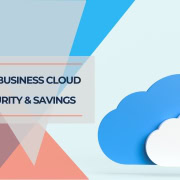Eight Compelling Reasons to Embrace Cloud Computing for Your Business in 2025
Eight Compelling Reasons to Embrace Cloud Computing for Your Business in 2025
Last Updated on May 24, 2025
Small businesses that have not yet adopted cloud computing may find themselves missing important operational advantages. As traditional desktop applications continue to decline in popularity, companies are increasingly turning to cloud services for practical business and operational reasons.
The cloud computing market has experienced substantial growth, reaching $752.44 billion in 2024 and projected to grow at a 20.4% compound annual growth rate through 2030, according to Grand View Research. Small and medium-sized businesses are leading this adoption, with 63% of SMB workloads now hosted in the cloud and over half of technology budgets allocated to cloud services in 2025.
Cloud computing delivers measurable benefits for businesses of all sizes, helping companies save money, increase productivity, and build resilience. Recent studies show that 88% of businesses report increased efficiency and agility from cloud investments, while 83% cite significant cost reductions and optimization.
Here are eight compelling reasons your business should embrace cloud computing in 2025:
Table of Contents
- 1 1. Significantly Reduce Technology Costs
- 2 2. Eliminate IT Maintenance and Support Overhead
- 3 3. Enable Seamless Remote and Hybrid Work
- 4 4. Integrated AI-Powered Business Solutions
- 5 5. Enterprise-Grade Security and Compliance
- 6 6. Flexible Scalability for Business Growth
- 7 7. Advanced Collaboration and Productivity Tools
- 8 8. Environmental Sustainability and Corporate Responsibility
- 9 Choosing the Right Cloud Platform
- 10 Implementation Best Practices
- 11 Conclusion
1. Significantly Reduce Technology Costs
Cloud computing changes how businesses approach IT spending, eliminating significant upfront capital expenses and reducing ongoing operational costs.
The Financial Impact: Rather than purchasing software licenses for every computer and upgrading hardware every few years, businesses pay predictable monthly subscriptions for cloud services. This approach provides access to enterprise-grade software without substantial initial investments. According to Deloitte research, small and medium businesses using cloud computing generate 21% more profit and grow 26% faster than their non-cloud counterparts.
Cost Savings Areas:
- Eliminated software licensing fees: No need to purchase individual licenses for multiple computers
- Reduced hardware requirements: Minimal local computing power needed for cloud-based applications
- Lower maintenance costs: Cloud providers handle software updates, security patches, and infrastructure maintenance
- Predictable budgeting: Monthly subscription costs replace unpredictable hardware failures and upgrade expenses
For businesses seeking comprehensive technology planning that incorporates cost-effective cloud solutions, exploring digital transformation strategies can provide valuable frameworks for optimizing technology investments.
2. Eliminate IT Maintenance and Support Overhead
Cloud computing transfers the responsibility of maintaining complex IT infrastructure from your business to specialized cloud providers, significantly reducing internal IT workload and costs.
Operational Benefits: Cloud providers employ dedicated teams of experts who monitor systems 24/7, apply security updates, and maintain infrastructure at enterprise levels that most small businesses cannot achieve independently. This arrangement allows business owners and employees to focus on core business activities rather than troubleshooting technical issues.
What's Handled by Providers:
- Automatic software updates: Applications receive immediate updates and new features without user intervention
- Security management: Continuous monitoring, threat detection, and vulnerability patching
- Infrastructure monitoring: Server performance, storage optimization, and network reliability
- Data backup and recovery: Automated backup systems with multiple redundancy levels
Businesses planning comprehensive IT infrastructure can benefit from reviewing small office technology planning to understand how cloud services integrate with overall technology strategies.
3. Enable Seamless Remote and Hybrid Work
Cloud computing has become essential for modern work arrangements, enabling employees to access business applications and data from any location with internet connectivity.
Remote Work Statistics: Remote work capabilities enabled by cloud technologies are anticipated to increase by 30% in 2025. This flexibility has become a competitive advantage for businesses recruiting talent and adapting to changing work preferences.
Access and Mobility Benefits:
- Device independence: Access files and applications from smartphones, tablets, laptops, or desktop computers
- Location flexibility: Work from home, client sites, or travel locations without losing productivity
- Real-time synchronization: Changes made on any device automatically sync across all platforms
- Collaboration tools: Video conferencing, shared documents, and project management accessible anywhere
Customer Service Enhancement: Mobile access to business systems enables field service teams, sales representatives, and consultants to access client information, process orders, and provide immediate responses while on-site with customers.
4. Integrated AI-Powered Business Solutions
Modern cloud platforms incorporate artificial intelligence capabilities that were previously accessible only to large enterprises, democratizing advanced technology for small businesses.
AI Integration Examples: Leading cloud productivity suites now include AI assistants that help with document creation, data analysis, and routine task automation. Microsoft 365 Copilot and Google Workspace's Gemini AI provide features such as:
- Automated content generation: AI assists with writing emails, creating presentations, and drafting documents
- Data analysis and insights: Intelligent analysis of spreadsheets and business data
- Smart scheduling and organization: AI-powered calendar management and meeting optimization
- Real-time language translation: Seamless communication across global teams
Business Impact: Companies using AI-integrated cloud platforms report saving 2-4 hours per week per employee on routine tasks, allowing teams to focus on strategic initiatives and customer-facing activities.
For businesses interested in leveraging AI capabilities, exploring AI tools for business automation provides insights into practical applications and implementation strategies.
5. Enterprise-Grade Security and Compliance
Cloud providers invest heavily in security infrastructure that surpasses what most small businesses can implement independently, offering protection levels typically reserved for large enterprises.
Security Advantages: 94% of businesses report improved security after moving to the cloud, according to research published by Microsoft. Cloud providers employ specialized security teams, implement advanced threat detection systems, and maintain compliance with industry regulations including HIPAA, PCI-DSS, and GDPR.
Security Features:
- Data encryption: Information protected both in transit and at rest using enterprise-grade encryption
- Multi-factor authentication: Advanced identity verification preventing unauthorized access
- Automated backup systems: Regular data backups stored in multiple geographic locations
- Threat monitoring: 24/7 security monitoring with immediate response to potential threats
- Compliance support: Built-in tools for meeting regulatory requirements
Business Continuity: Cloud-based data storage across multiple data centers ensures business continuity even if local systems fail or natural disasters affect physical office locations.
Organizations planning comprehensive security strategies can benefit from reviewing cybersecurity best practices that complement cloud security measures.
6. Flexible Scalability for Business Growth
Cloud computing provides the ability to scale technology resources up or down based on business demands without significant infrastructure investments or long-term commitments.
Scalability Benefits:
- Immediate resource adjustment: Increase storage, processing power, or user accounts within minutes
- Seasonal flexibility: Scale up during busy periods and reduce costs during slower times
- Geographic expansion: Add users in new locations without establishing local IT infrastructure
- Feature enhancement: Access to new tools and capabilities as business needs evolve
Growth Support: Cloud platforms enable rapid business expansion by providing instant access to enterprise-level tools and capabilities. Companies can launch new products, enter new markets, or onboard additional employees without delays related to IT infrastructure setup.
Cost Efficiency: Pay-as-you-use pricing models ensure businesses only pay for resources they actually utilize, avoiding overprovisioning and reducing waste in technology spending.
7. Advanced Collaboration and Productivity Tools
Modern cloud platforms offer sophisticated collaboration capabilities that enhance team productivity and enable new working methods not possible with traditional software.
Collaboration Features:
- Real-time document editing: Multiple team members can simultaneously work on documents, spreadsheets, and presentations
- Integrated communication: Chat, video conferencing, and file sharing within unified platforms
- Project management: Built-in tools for task tracking, deadline management, and team coordination
- Version control: Automatic tracking of document changes with ability to restore previous versions
Productivity Impact: Companies investing in collaborative cloud technologies experience up to 400% increase in productivity according to research by Frost & Sullivan. Teams report faster decision-making, reduced email volume, and improved project completion rates.
Global Team Support: Cloud collaboration tools enable businesses to build and manage distributed teams effectively, accessing talent regardless of geographic location while maintaining operational efficiency.
8. Environmental Sustainability and Corporate Responsibility
Cloud computing supports environmental sustainability goals by improving energy efficiency and reducing the carbon footprint of business technology operations.
Environmental Benefits:
- Shared infrastructure: Multiple businesses share computing resources, reducing overall energy consumption
- Optimized data centers: Cloud providers operate highly efficient facilities with advanced cooling and power management
- Reduced hardware waste: Longer equipment lifecycles and professional recycling programs
- Lower transportation impact: Reduced need for on-site IT maintenance and hardware deliveries
Sustainability Goals: 50% of cloud providers are expected to have carbon-neutral data centers by 2025. Energy-efficient cloud solutions are projected to reduce IT-related carbon emissions by 20%, supporting corporate sustainability initiatives.
Business Value: Environmental responsibility increasingly influences customer purchasing decisions and employee satisfaction. Cloud computing enables businesses to demonstrate commitment to sustainability while improving operational efficiency.
Choosing the Right Cloud Platform
Success with cloud computing depends on selecting platforms that align with business needs and workflows. The two leading productivity suites offer different advantages:
Microsoft 365 excels for businesses requiring feature-rich desktop applications, advanced data analysis tools, and integration with existing Microsoft-based systems. The platform includes comprehensive business applications with AI-powered Copilot features that enhance productivity across Word, Excel, PowerPoint, and Teams.
Google Workspace provides excellent value for businesses prioritizing real-time collaboration, mobile access, and straightforward cloud-native workflows. The platform's Gemini AI features offer intelligent assistance for content creation and data analysis within Gmail, Docs, Sheets, and other applications.
Both platforms offer robust security, compliance features, and integration capabilities. The choice typically depends on existing technology preferences, specific feature requirements, and budget considerations.
Implementation Best Practices
Successful cloud adoption requires planning and gradual migration rather than immediate complete transitions.
Migration Strategy:
- Start with non-critical applications: Begin with file storage and basic productivity tools
- Provide employee training: Ensure team members understand new tools and workflows
- Maintain data backups: Keep multiple backup copies during transition periods
- Monitor performance: Track productivity and cost metrics to measure success
Ongoing Optimization: Regular review of cloud usage and costs helps businesses optimize their investments and take advantage of new features and capabilities as they become available.
For businesses needing guidance on cloud migration and implementation, consulting with experienced IT professionals can ensure smooth transitions and optimal configuration for specific business needs.
Conclusion
Cloud computing has evolved from an emerging technology trend to an essential business tool that enables growth, efficiency, and competitiveness. The benefits extend far beyond simple cost savings to encompass improved security, enhanced collaboration, AI-powered productivity, and sustainable business practices.
With 85% of organizations expected to be “cloud first” by 2025, businesses that delay cloud adoption risk falling behind competitors who leverage these advantages. The technology has matured to provide reliable, secure, and cost-effective solutions for businesses of all sizes.
The question for business leaders is no longer whether to adopt cloud computing, but rather how quickly and effectively they can implement cloud solutions to drive business success. Starting with basic cloud services and gradually expanding capabilities allows businesses to realize immediate benefits while building expertise for more advanced implementations.
Modern cloud platforms offer the tools, security, and support necessary for businesses to thrive in an increasingly digital economy. By embracing cloud computing, businesses position themselves for sustainable growth, improved operational efficiency, and enhanced competitive advantage in 2025 and beyond.
If you have questions about cloud computing implementation or need assistance selecting the right cloud strategy for your business, professional consultation can provide the expertise necessary to ensure successful adoption and optimization of cloud technologies for your specific needs.











Leave a Reply
Want to join the discussion?Feel free to contribute!